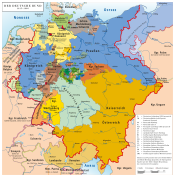
The states of the German Confederation were member states of the German Confederation, from 20 June 1815 until 24 August 1866.
On the whole, its territory nearly coincided with that remaining in the Holy Roman Empire at the outbreak of the French Revolution, with the notable exception of Belgium. Except for the two rival major powers, Austria and Prussia, and the western left bank of the Rhine (which France had annexed, with tiny Katzenelnbogen), the other member states (or their precursors) had been within Napoleon's Confederation of the Rhine.
Empire
[edit]1. The Austrian Empire, excluding the Kingdom of Hungary, the Principality of Transylvania, and the Kingdom of Croatia (all of which became parts of the apostolic kingdom of Hungary within the Danubian Dual Monarchy), the Kingdom of Lombardy–Venetia (constituting parts lost to Italy in 1859- viz. 1866), the Duchy of Bukovina, and the kingdoms of Dalmatia and Galicia (but including, from 1818 till 1850, Duchy of Oświęcim and Duchy of Zator)
- Archduchy of Austria (split into Upper Austria and Lower Austria in 1849)
- Kingdom of Bohemia
- Margraviate of Moravia
- Grand Duchy of Salzburg
- Duchy of Carinthia
- Duchy of Carniola
- Duchy of Upper and Lower Silesia
- Duchy of Styria
- Littoral (consisting of Gorizia and Gradisca, Istria and Trieste)
- County of Tyrol
- Vorarlberg
Kingdoms
[edit]2. The Kingdom of Prussia (excluding Posen, East Prussia and West Prussia)
- Brandenburg
- Pomerania
- Rhine Province (until 1822 the Grand Duchy of the Lower Rhine and the Province of Jülich-Cleves-Berg)
- Saxony
- Silesia
- Westphalia
3. The Kingdom of Bavaria
- Upper Bavaria
- Upper Franconia
- Swabia
- Upper Palatinate
- Middle Franconia
- Lower Bavaria
- Lower Franconia
- Palatinate
4. The Kingdom of Hanover (in personal union with the United Kingdom until 1837)
5. The Kingdom of Saxony
6. The Kingdom of Württemberg
Electorates
[edit]7. The Electorate of Hesse (also known as Hesse-Kassel)
Grand Duchies
[edit]8. The Grand Duchy of Baden
9. The Grand Duchy of Hesse (also known as Hesse-Darmstadt)
10. The Grand Duchy of Luxemburg (in personal union with the United Kingdom of the Netherlands; lost over half of its territory in the west to Belgium in the breakup of the United Kingdom of the Netherlands in 1839, thereby resulting in the Duchy of Limburg becoming a member.)
11. The Grand Duchy of Mecklenburg-Schwerin
12. The Grand Duchy of Mecklenburg-Strelitz
13. The Grand Duchy of Oldenburg
14. The Grand Duchy of Saxe-Weimar-Eisenach
Duchies
[edit]15. The Duchy of Brunswick (prior Brunswick-Lunenburgian Principality of Wolfenbüttel)
16. The Duchy of Holstein (in personal union with the Kingdom of Denmark; not a former member of the Confederation of the Rhine)
17. The Duchy of Limburg (became a member in 1839 in personal union with the Netherlands as compensation for territorial losses in the Grand Duchy of Luxemburg that were caused by the breakup of the United Kingdom of the Netherlands.)
18. The Duchy of Nassau
19. The Duchy of Saxe-Coburg-Saalfeld (Saxe-Coburg and Gotha from 1826)
20. The Duchy of Saxe-Gotha-Altenburg (Saxe-Altenburg from 1826)
21. The Duchy of Saxe-Hildburghausen (dissolved in 1826; territory merged with Saxe-Meiningen)
22. The Duchy of Saxe-Lauenburg (in personal union with the Kingdom of Denmark)
23. The Duchy of Saxe-Meiningen
24. The Duchy of Anhalt-Bernburg (merged with Anhalt-Dessau in 1863)
25. The Duchy of Anhalt-Dessau (Duchy of Anhalt-Dessau-Köthen from 1853; Duchy of Anhalt from 1863)
26. The Duchy of Anhalt-Köthen (merged with Anhalt-Dessau in 1853)
The Duchy of Schleswig was never a member state. But Schleswig was traditionally connected to the duchies of Holstein and Lauenburg, which were member states. In 1848-51 (during the First Schleswig War), it was treated by the German states and the short-lived German Empire as a kind of member. In 1864, the Danish king transferred the three duchies to Austria and Prussia (after the Second Schleswig War).
Principalities
[edit]27. The Principality of Hohenzollern-Hechingen (merged with Kingdom of Prussia in 1850)
28. The Principality of Hohenzollern-Sigmaringen (merged with Kingdom of Prussia in 1850)
29. The Principality of Liechtenstein
30. The Principality of Lippe
31. The Principality of Reuss Junior Line
32. The Principality of Reuss Senior Line
33. The Principality of Schaumburg-Lippe
34. The Principality of Schwarzburg-Rudolstadt
35. The Principality of Schwarzburg-Sondershausen
36. The Principality of Waldeck and Pyrmont
Landgraviates
[edit]37. The Landgraviate of Hesse-Homburg (became a member in 1817; merged with Grand Duchy of Hesse in 1866)
Free and Hanseatic Cities
[edit]38. The Free Hanseatic City of Bremen (still a constitutive state of Germany)
39. The Free City of Frankfurt upon Main
40. The Free and Hanseatic City of Hamburg (still a constitutive state of Germany)
41. The Free and Hanseatic City of Lübeck
The four free cities were republics by constitution, while all the others were monarchies, some constitutional and some absolutist.
Sources and references
[edit]- Westermann, Großer Atlas zur Weltgeschichte (in German, detailed maps)
- WorldStatesmen
